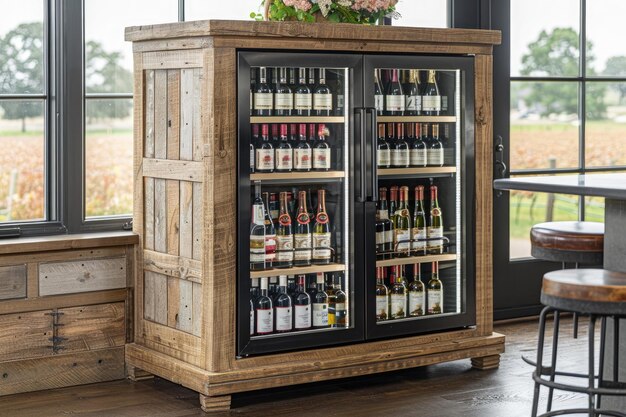Storing Red Wine: Should You Use the Refrigerator?
Red wine lovers often wonder about the ideal way to store their favorite bottles. One common misconception is that all wines, like whites and sparkling varieties, can be stored in the refrigerator. But when it comes to red wine, is refrigeration really the best option? Let's explore this topic in depth and provide you with a comprehensive guide to help you make the best choice for your wine storage needs.
🍇 Understanding Red Wine Storage Basics
Storing red wine properly is key to preserving its flavors and characteristics. Unlike white wine, red wine's fuller body and tannins require different conditions for optimal preservation.
Factors Affecting Red Wine Storage
- Temperature: Red wine should be stored at a consistent temperature between 55°F and 65°F (13°C to 18°C). Fluctuating or extreme temperatures can age the wine faster or deteriorate its quality.
- Light: Exposure to light, especially sunlight, can degrade red wine by causing chemical reactions that alter its flavor.
- Humidity: Ideally, humidity levels should be around 70% to 80% to prevent the cork from drying out and allowing air into the bottle.
- Vibration: Constant or frequent movement can disturb the sediment in red wine, affecting the taste.
Understanding these factors is crucial for maintaining the quality of your red wine, whether you're exploring various storage options or considering refrigeration.
🧊 Can You Refrigerate Red Wine?
Refrigerating red wine is often debated among wine enthusiasts. Let’s break down the advantages and drawbacks.
Advantages of Refrigerating Red Wine
- Short-term Solution: If you've opened a bottle and plan to finish it within a few days, storing it in the refrigerator can prolong its life by slowing oxidation.
- Stability: Refrigerators provide a stable temperature environment, protecting the wine from temperature fluctuations.
- Preservation: For some fuller-bodied wines, refrigeration may slightly enhance their flavors by preserving their original qualities.
Drawbacks of Refrigerating Red Wine
- Temperature Concerns: The typical fridge temperature (below 40°F) is colder than desired for red wine storage, which can impact the wine’s bouquet and taste.
- Flavor Changes: Prolonged exposure to cold can mute the flavors that are characteristic of red wines, like their rich fruitiness and complex tannins.
- Humidity Levels: Refrigerators have low humidity, which risks drying out the cork and allowing air to seep in, possibly leading to spoilage.
When Refrigeration is a Good Choice
For short-term storage, especially for open bottles, refrigeration is acceptable. Just remember to let the wine come up to an appropriate serving temperature before enjoying it.
🍷 Serving Red Wine: At What Temperature?
Serving temperature impacts the taste and aroma of red wine. Here's how you can ensure your wine is perfect for sipping:
- Full-bodied Reds (Cabernet Sauvignon, Syrah): Best enjoyed at 60-65°F (16-18°C)
- Medium-bodied Reds (Merlot, Chianti): Ideal at 57-61°F (14-16°C)
- Light-bodied Reds (Pinot Noir, Gamay): Serve slightly cooler at 55-57°F (13-14°C)
Allowing wine to warm up gradually to these temperatures can be achieved by taking it out of the refrigerator 30 minutes to an hour before serving.
🏡 Other Storage Options for Red Wine
While the refrigerator might work for short-term storage, consider alternatives for long-term:
Wine Cooler or Fridge
A wine cooler is designed specifically for storing wine at an optimal temperature and humidity level. It offers separate settings for different types of wine, making it ideal for those who have a varied collection.
Wine Cellar
For collectors or serious enthusiasts, a wine cellar provides the perfect environment — stable temperature, ideal humidity, and protection from light and vibrations.
Wine Rack in a Cool, Dark Place
If you don't have access to a wine fridge or cellar, find a spot in your home that remains cool, dark, and relatively stable throughout the year. A basement or a closet away from direct sunlight is often a good choice.
📝 Key Takeaways: Storing Red Wine
Here's a handy summary to keep your red wine in perfect condition:
- Short-term Storage: Refrigerate opened red wine to prolong its life, but allow it to warm up before serving.
- Long-term Storage: Aim for a dedicated wine fridge or cooler. If unavailable, choose a cool, dark place at home.
- Avoid Direct Sunlight and Vibration: These factors can degrade quality over time.
- Humidity Matters: Prevent corks from drying out by maintaining appropriate humidity.
🤔 Frequently Asked Questions
Can I Store an Unopened Bottle of Red Wine in the Refrigerator?
It's best to avoid storing unopened bottles in the refrigerator due to potential impacts on flavor and cork integrity. Keep them in a wine cooler or a properly conditioned environment instead.
How Long Can I Refrigerate Opened Red Wine?
For most red wines, refrigeration can extend freshness for about 3 to 5 days. The wine may last longer, but its flavors and aromas will start to degrade.
What If My Room Isn't Cool Enough for Storing Red Wine?
Consider investing in a small wine cooler, which is more affordable than one might assume and effectively maintains the ideal conditions for red wine storage.
Does Screw Cap Red Wine Need the Same Humidity Levels?
While less susceptible to cork-related issues, even screw cap wines benefit from a consistent, cool storage environment to maintain quality over time.
🌟 Empowering the Wine Enthusiast in You
Storing red wine doesn’t need to be complicated. By understanding storage fundamentals and considering your specific circumstances, you can enjoy your wines at their best. Whether you're savoring a bold cabernet or a delicate pinot noir, these insights and options empower you to make informed decisions. So, go ahead and fill your glass — cheers to perfect wine moments!
